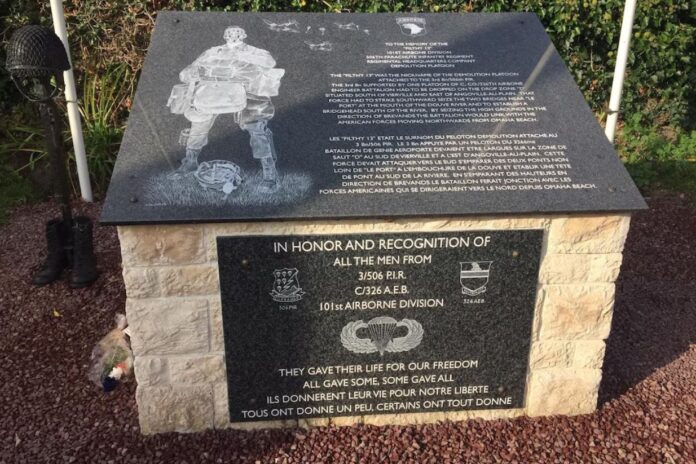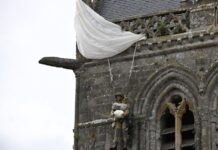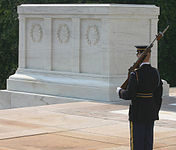Photo: Filthy Thirteen Monument (U.S. Army).
During World War II, a group of American paratroopers known as the Filthy Thirteen gained notoriety for their rebellious spirit and fierce combat effectiveness. Officially designated as the 1st Demolition Section of the Regimental Headquarters Company, 506th Parachute Infantry Regiment, 101st Airborne Division, these soldiers were tasked with critical demolition missions behind enemy lines in the European theater.
Led by Sergeant Jake McNiece, a man of partial Choctaw heritage, the unit became famous for their distinctive appearance, often sporting mohawk haircuts and applying war paint before missions—a nod to McNiece’s Native American roots. This unconventional style, coupled with their disregard for standard military discipline, earned them the moniker “Filthy Thirteen.” Their antics, such as using bathwater rations to cook game they had poached, further cemented their legendary status.
The Filthy Thirteen’s first major operation was during the Normandy Invasion in June 1944. Parachuting behind enemy lines, they were tasked with securing or destroying bridges over the Douve River to hinder German reinforcements. Despite suffering significant casualties during the jump, the surviving members successfully completed their mission, contributing to the Allied forces’ efforts in the region.
In September 1944, during Operation Market Garden, the unit was assigned to defend bridges over the Dommel River in Eindhoven, Netherlands. A German bombing raid resulted in heavy losses, but the remaining members continued to serve valiantly, often taking on roles beyond their demolition expertise. Their adaptability and resilience were evident as they secured regimental command posts and protected communication lines.
Following their actions in the Netherlands, McNiece and several others volunteered for the Pathfinders, elite paratroopers who would jump ahead of main forces to set up drop zones. Unexpectedly, they found themselves deployed during the Battle of the Bulge, parachuting into the besieged town of Bastogne to assist in its defense. Their presence bolstered the morale of the encircled American forces and played a role in holding the town against German assaults.
The exploits of the Filthy Thirteen inspired the 1965 novel and subsequent 1967 film “The Dirty Dozen,” though the Hollywood portrayal took creative liberties. Unlike the fictionalized version, the real Filthy Thirteen were not convicts but rather a group of dedicated soldiers whose unorthodox methods and fierce determination left an indelible mark on military history. Their legacy endures as a testament to the diverse paths to heroism in times of war.
Monument to the Filthy Thirteen
A monument to the Filthy Thirteen was dedicated on June 6, 2008. It stands on the southwest corner of the intersection of D89E and Rue du Moulin. The official Google Maps address is Rue du Moulin, 50500 Carentan-les-Marais, France.























